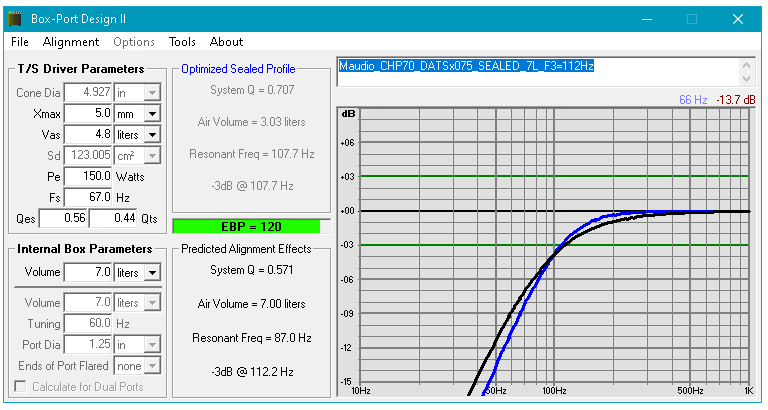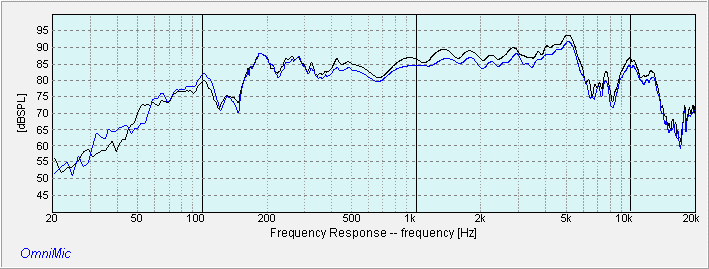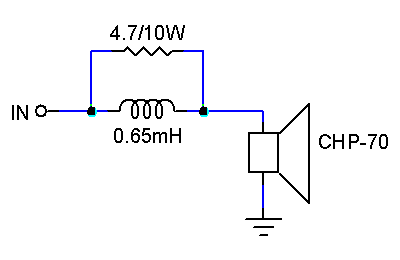|
Markaudio CHP-70-P Gen2 Bass Reflex (7 Liters)
As promised, this post is about the Markaudio CHP-70-P Gen2 in a bass reflex. The enclosure is the same as in the 7 liters sealed version. Box width remains at 8″. The bass reflex is tuned to 65Hz with a port of 1.5″ diameter and a length of 3.75″. Below is the predicted bass response. Due to the nature of a bass reflex, the F3 has been lowered to 59Hz.

Comparing this to the sealed box with an F3 of 112Hz (below), the bass reflex lowered the F3 by 53Hz. That is not a small amount. Considering the CHP-70 is a small 4″ woofer, this is actually quite impressive. More so when the System Q is at 0.57.

Tonality of CHP-70 Bass Reflex
When I first heard the CHP70 in a bass reflex, I was quite disappointed. She lost the tight upper bass that was so appealing in the sealed box. The bass is lower but nothing impressive unlike in the sealed box.
I found the midrange to be slightly shouty so I proceeded to lower it with a BSC network. In my first attempt, the midrange was over-compensated. The vocals lost the clarity and receded into the background. Worse than that, the bass was overpowering. Drowned the midrange.
I then tweaked the BSC and after a few tries, everything came together. The vocals jumped out. The bass is still audible but this time it didn’t over-power the vocals. In fact, bass clarity improved tremendously too. This tweaking is done strictly by ear.
Below is the FR of the CHP-70 in a bass reflex with the final BSC network (Blue plot). The Black plot is the FR in a sealed box with no BSC. As can be seen, it is only about 2dB but it makes a world of difference.
Frequency Response with Baffle Step Compensation (BSC)

Baffle Step Compensation Network
The BSC network is very simple. The inductor is 0.65mH (air core 18awg) with a 4.7 ohm 10W resistor in parallel. This network will reduce the midrange as shown in the Blue plot above.
Some Full-Range users are adverse to using any components in their build. They focus their attention on getting more bass, even resorting to esoteric designs like Voigt pipes and Transmission lines. There’s nothing wrong with that. However, that only address the bass, not the midrange. If you find your CHP-70 fatiguing to listen to, I advise installing this BSC network.
Sound of CHP-70 Bass Reflex
To test out the bass, I put on Another Sad Love Song (Toni Braxton). This song has a distinctive bass track. I’m relieved to find that the bass came out clear and extends down to make the bass sounds natural.
Up next is She Works Hard for the Money (Donna Summers). This song is excellent for bass. It runs throughout the song. The bass goes deep enough and is tight and punchy.
The CHP-70 control of the cone is outstanding. You only get this kind of bass performance from woofers in the $100+ price range.
Summary
I must admit I’m impressed with this Markaudio CHP-70-P Gen2. It took me a long time to find the sweet spot. I don’t think any 4″ woofers I have can match the sound quality of this little fellow. She is “fast”, meaning realistic. There’s no harshness in the treble. Vocals are superb. If you get the bass right, she sounds heavenly. All for a measly $36. Incredible. It can’t get simpler than this.
Completing the CHP-70-P Gen2
While the CHP70 on her own sounds fantastic, her bass is still lacking to qualify as a full range system. For that, a subwoofer is needed. The easiest way is to use a bandpass subwoofer.
Of the many bandpass subs at my disposable, I selected the Toucan-SF. Housed within the 25 liters box is an 8″ Silver Flute W20RC38-08 woofer. This 8″ is not too costly yet performs well in a bandpass.
I set my 24dB/oct electronic crossover at 60Hz and adjusted the volume by ear. As I had hoped, it worked out splendidly. The bass is now solid and extends down to 40Hz. At such a low crossover frequency (60Hz), the bandpass bass is kept well away from the upper bass of the CHP-70. The midrange clarity is not compromised.
The CHP-70 with the Toucan-SF bandpass subwoofer are a match made in heaven. Cheap and very pleasant to listen to.
Unless otherwise stated, all measurements were made with the mic at 36 ins, tweeter axis. Impulse Window=5ms. No smoothing applied. |




